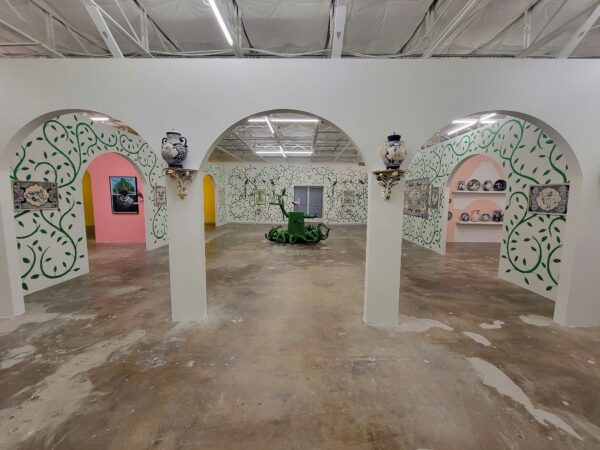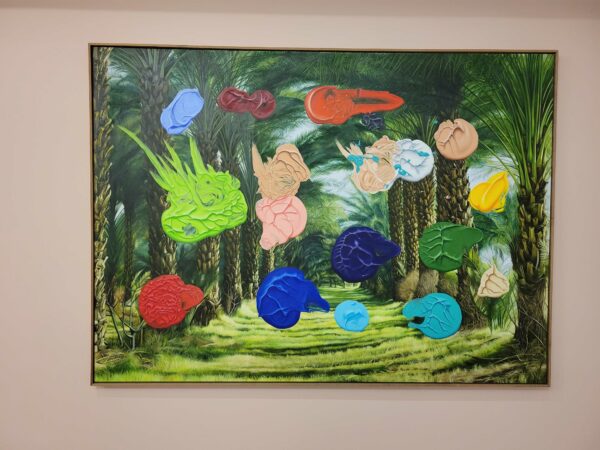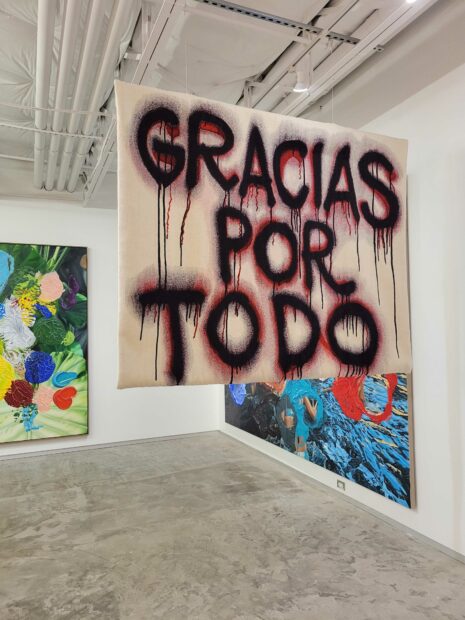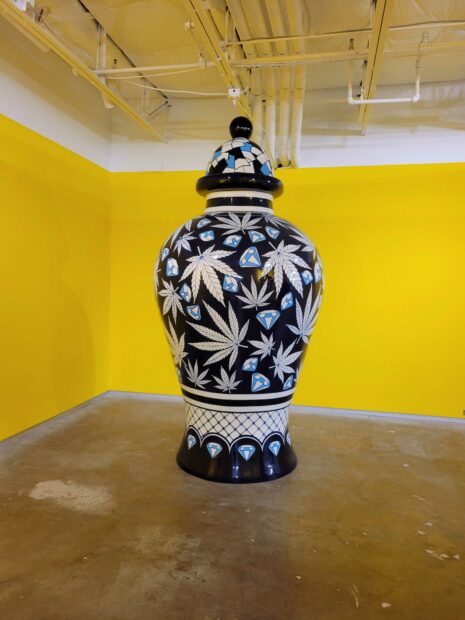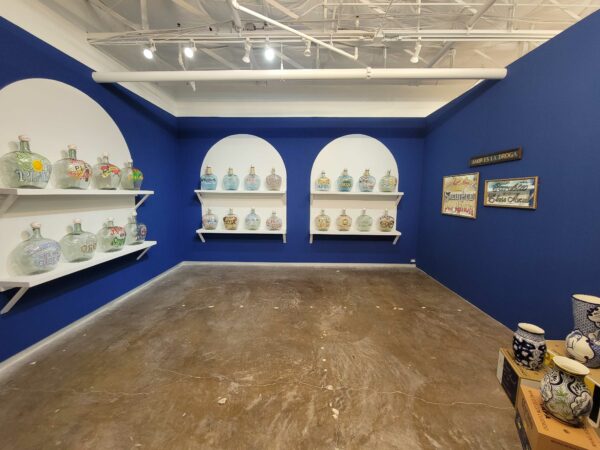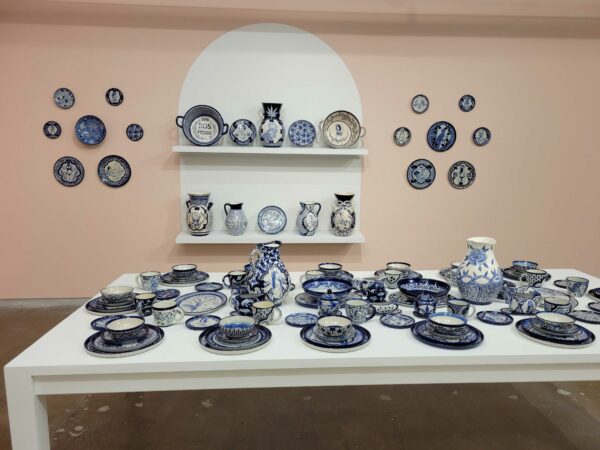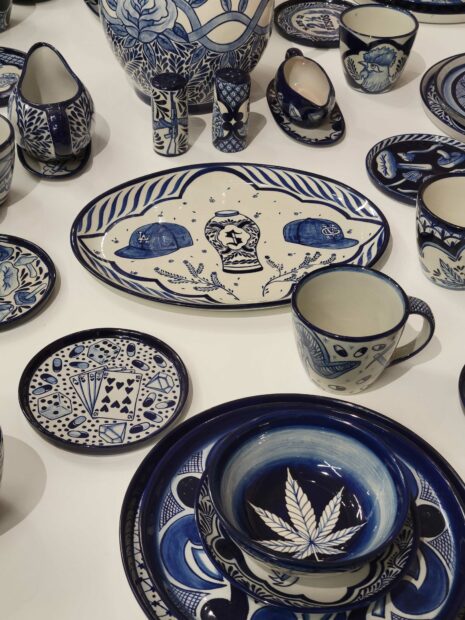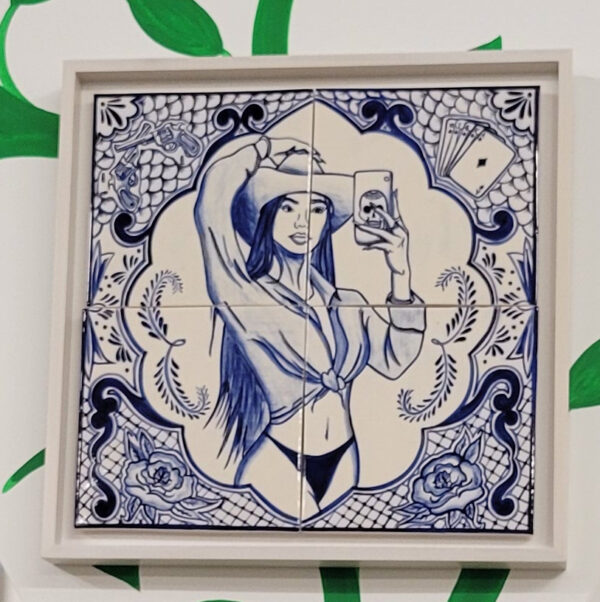This Must Be the Place is a fitting title for Eduardo Sarabia’s exhibition at Dallas Contemporary. If you are a Talking Heads fan like me, then you know this is an exhibition about coming home, and for it Sarabia has literally invited visitors into a Mexican hacienda. To be clear, this is not some nostalgic representation of Mexico. Instead, this is an opportunity for visitors to follow the artist’s journey to his ancestral, artistic, and now physical home in Mexico through an intimate view of the complex inter-cultural histories that have shaped his art and personal story.
Upon entry into the exhibition, visitors are treated to Sarabia’s lush, large-scale oil on linen paintings. Oasis features a grassy path through an alley of palm trees in photo-realistic detail, except for splotches of paint obscuring the view. This is a fitting welcome to the show, enticing viewers with a promise of beautiful views, but making clear that this is a construction, an artistic fantasy. These works also set the stage for an exhibition that explores the interior and exterior. The show is arranged into a hacienda layout, including an entry, studio, chapel, cellar, and kitchen radiating from a central courtyard. With this unique structure, visitors feel the sense of traveling through an unnamed person’s home, but beyond taking in their physical environment we get a glimpse at their inner world, their inner desires.
How does one capture a place? While landscapes are one prominent tool, material culture, like ceramics, provides distinct access to the lived experiences of the people that inhabit a place and give it unique culture. However, it is often tempting to use traditional crafts and artisanal practices to freeze cultures in past eras. Sarabia’s exhibition masterfully subverts this dynamic. Well-versed in a variety of traditional craft practices, like Talavera ceramics and mezcal, Sarabia infuses these Mexican traditions with new life by incorporating pop culture references from Mexico and the United States, Sarabia’s former home.
The less we say about it the better
Make it up as we go along
Sarabia’s own journey from Los Angeles to Mexico is fascinating. His parents immigrated to the United States in pursuit of the long mythic American Dream. His grandfather, Felipe Sarabia, spent much of his life dreaming of gold, in particular a rumored treasure reportedly buried by missionaries prior to the Mexican War of Independence. Thus, there was a generational inheritance of striving for something better that many of the show’s visitors can relate to.
Sarabia grew up in Los Angeles and developed his own path to a better life through art. He followed his artistic dreams and moved to Guadalajara to begin working with Cerámica Suro. It was there that he decided to pick up where his grandfather’s dream left off. Using maps and notes he inherited, he gathered a team and set off to find gold in Sinaloa. This bold expedition ultimately ended after encountering a cartel, but Sarabia has previously noted the importance of his genuine interactions with members of the cartel, including a man interested in art.
Transitioning into the studio, visitors are treated to several small works on paper that reference gold and Mazatlán (Sinaloa). Most striking is a suspended wool banner that serves as a sign. Referencing the narcomantas, or spray painted signs with coded messages typically associated with gangs and cartels, this particular sign reads “Gracias por Todo.” Formally, this body of work reflects Sarabia’s interest in highlighting the diverse artisanal practices of Mexico. Though appearing visually simple, Sarabia’s Narcomantas are created in collaboration with the Taller de Gobelinos, a tapestry studio, and typically take months to craft. This is one of the aspects I love most about Sarabia’s work: It takes the seemingly simple and encourages us to acknowledge its true complexity. The same can be extended to the independent, illicit economies of Mexico and the United States, as well.
When considering the gangs and drug cartels, it is hard to look past their violence and ruthless cruelty. Yet, Sarabia’s work evokes a more nuanced, dichotomous perspective. These are real people with individual stories. What draws a person to that type of life? Likely a dream of more, perhaps a dream of gold and riches. Rather than taking a judgmental approach, Sarabia’s work invites viewers to consider their own aspirations and re-evaluate how much really separates them from the unnamed occupant of this fictitious hacienda.
In the chapel, this is placed in stark focus. A chapel is typically a revered, spiritual place. Yet the focal point of this space is a monumental fiberglass vase adorned with marijuana leaves and diamonds. I cannot help but wonder what is stashed inside this vase. Is it already filled with these coveted items? Or is this a money jar, carefully being filled in hopes of one day having an abundant supply? More importantly, what does this say about what we worship in 2023?
Never for money
Always for love
Directly opposite the chapel is the cellar, filled with multiple shelves of glass mezcal bottles, each beautifully decorated with painted text and baseball toppers. Again, Sarabia highlights the industries of his adopted homeland — glass work and mezcal production. Yet it avoids feeling like a touristy, promotional display. This is where the feel of the exhibition begins to shift. While the studio and chapel feel like private spaces, the cellar creates a sense of community. One acquires this many bottles in hopes of sharing with others. Ultimately the dream is not solely for oneself, but to have better for those we love.
With regard to bringing people together, the kitchen gallery has an elaborate place setting highlighting the high-volume output of Sarabia’s ceramics. While this exhibition truly reflects Sarabia’s wide-ranging practice, including painting, stained glass, and works on paper, the heart of the exhibition is the ceramics. Showcasing both tiles and serving ware, Sarabia’s relationship with Cerámica Suro is a prominent theme of the show. Although drawing upon the traditional Talavera style, Sarabia adds a contemporary twist, departing from traditional floral motifs and instead including pop culture references.
It’s ok I know nothing’s wrong…nothing
It is worth taking a moment to explore the elements presented, as each has a unique design. With references to assault weapons, pills, playing cards, the Los Angeles Dodgers, and roosters, Sarabia is pulling together many cultural references that are wide open to interpretation. It is provocative and engaging, but also frustrating in its lack of clarity. How are we to make sense of these references? What are we to take away? A clear example is the rooster. Roosters can symbolize many things, including confidence, good luck, and even resurrection. My first association is that it is a cock, with the many assumptions I have as a United States millennial about that term. Is this a hyper-masculine presentation of aspiration and attainment? There is a long history of cockfighting in Mexico, particularly in small communities; it reflects machismo culture. Yet there is a highly domestic feel to this presentation of ceramics, particularly with the light pink walls and the formation of facing birds formed from cups hanging on the walls. I was left with an uncertain notion of relationships after leaving this room. Is this a bachelor pad or shared home? What is the role of women in this space, and whose perspective is being presented?
Women are repeatedly featured in Sarabia’s works. Many of his ceramics depict women in bikinis, seductively posed. Two of my favorites, found in the central courtyard, feature women holding cell phones, presumably in the act of taking selfies. These are my favorites in that they bestow agency on these women. They are not just passively being consumed as sexual objects. Rather, they are actively fashioning themselves as desirable beings in a consumer society. Perhaps they view this as one avenue to attaining the objects and lifestyle they desire.
Home, is where I want to be
But I guess I’m already there
The quest for gold has long brought people to Mexico, as they envision a beautiful paradise where gold flows plentifully. That quest was continued by Eduardo Sarabia and the many individuals taking part in the independent economies of Mexico. Drawing upon pop culture and traditional practices, Sarabia’s works capture the quest of many everyday people striving for a dream on both sides of the Mexico and United States border. This must be the place. This must be the destination, the goal. The question remains whether this place can really be found. For Sarabia, he may not have found the gold his grandfather once sought, but he has found something truly special. His art allows him to manifest his own dream, to create spaces that truly embody his family, his life’s journey, and his cultures as a Mexican and American artist.
Eduardo Sarabia: This Must Be the Place is on view at Dallas Contemporary through September 24, 2023.
Italicized song lyrics throughout from the Talking Heads’ “This Must Be the Place (Naïve Melody),” (1983).


